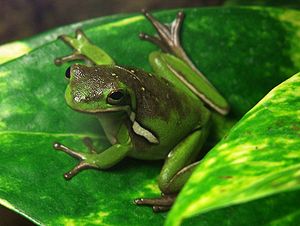Karolina tree frog
| Karolina tree frog | ||||||||||||
|---|---|---|---|---|---|---|---|---|---|---|---|---|

Karolina tree frog ( Dryophytes cinereus ) |
||||||||||||
| Systematics | ||||||||||||
|
||||||||||||
| Scientific name | ||||||||||||
| Dryophytes cinereus | ||||||||||||
| ( Schneider , 1799) | ||||||||||||
| Subspecies | ||||||||||||
|
The Karolina tree frog ( Dryophytes cinereus , synonym : Hyla cinerea ), also known as the American tree frog , belongs to the family of tree frogs ( Hylidae ), subfamily of the tree frogs iwS (Hylidae)
habitat
The species occurs in three subspecies in the southeastern United States to southern Texas. Preferred habitat are trees in damp forests or dense vegetation on the edge of ponds or slowly flowing water. The Karolina tree frog is nocturnal; it usually spends the day with its limbs clasped up against a branch or reed stalk.
Appearance
The frog is light green on top with a whitish, dark-lined longitudinal stripe on the head and body side and individual light speckles on the back; the belly is white. The color changes from yellow-green to dark brown depending on the temperature. Its head-torso length is 60 to 63 mm. The slightly smaller males have a vocal sac on their throats . In spring and summer they let their call be heard at night, a repeated, metallic-sounding croak that reminds of cowbells in the chorus (audio samples).
development
The mating season begins in March, in the northern range in May, and lasts until summer. The spawn is deposited in numerous clumps in ponds or on aquatic plants. The tadpoles hatch within four to six days and spend around 60 days in the water until the metamorphosis is complete.
Pair in amplexus
Calling Man (Video)
Web links
- Dryophytes cinereus in the endangered Red List species the IUCN 2006. Posted by: Hammerson & Hedges, 2004. Retrieved on 12 May, 2006.
Individual evidence
- ↑ Sounds of Green Treefrog - Hyla cinerea ( English ) California Herps. Retrieved June 7, 2019.



